Inter-Sectoral Linkage and External Trade Analysis for Virtual Water and Embodied Carbon Emissions in China
Abstract
:1. Introduction
2. Materials and Methods
2.1. Data
2.2. Methodologies
2.2.1. Input–Output Analysis
2.2.2. Environmental Input–Output Analysis
2.2.3. Inter-Sectoral Linkage Analysis of Virtual Water and Embodied Carbon Emissions
2.2.4. Virtual Water or Carbon Emissions Trade between China and Other Regions
3. Results
3.1. Linkage Analysis
3.1.1. Linkage Analysis of Water Consumption
3.1.2. Linkage Analysis of Carbon Emissions
3.2. Trade between China and Other Regions
3.2.1. Virtual Water Trade
3.2.2. Embodied Carbon Emissions Trade
4. Discussion
4.1. Virtual Water Flow Chains
4.2. Embodied Carbon Emissions Flow Chain
4.3. Policy Implications
5. Conclusions
Author Contributions
Funding
Acknowledgments
Conflicts of Interest
References
- Ercin, A.E.; Hoekstra, A.Y. Carbon and Water Footprints Concepts, Methodologies and Policy Responses; United Nations World Water Assessment Programme; UNESCO: London, UK, 2012. [Google Scholar]
- FAO (Food and Agriculture Organization of the United Nations). Climate Change, Water and Food Security; FAO: Rome, Italy, 2011. [Google Scholar]
- Soytas, U.; Sari, R.; Ewing, B.T. Energy consumption, income, and carbon emissions in the United States. Ecol. Econ. 2007, 62, 482–489. [Google Scholar] [CrossRef]
- Herrmann, I.T.; Hauschild, M.Z. Effects of globalization on carbon footprints of products. CIRP Ann.-Manuf. Technol. 2009, 58, 6–13. [Google Scholar] [CrossRef]
- Allan, J.A. Virtual water—The water, food, and trade nexus: Useful concept or misleading metaphor? Water Int. 2003, 28, 106–113. [Google Scholar] [CrossRef]
- Zeitoun, M.; Allan, J.A.; Mohieldeen, Y. Virtual water “flows” of the Nile Basin, 1998–2004: A first approximation and implications for water security. Glob. Environ. Chang. 2010, 20, 229–242. [Google Scholar] [CrossRef]
- Chouchane, H.; Krol, M.S.; Hoekstra, A.Y. Virtual water trade patterns in relation to environmental and socioeconomic factors: A case study for Tunisia. Sci. Total Environ. 2018, 613–614, 287–297. [Google Scholar] [CrossRef] [PubMed]
- Wahba, S.M.; Scott, K.; Steinberger, J.K. Analyzing Egypt’s water footprint based on trade balance and expenditure inequality. J. Clean. Prod. 2018, 198, 1526–1535. [Google Scholar] [CrossRef]
- Brindha, K. International virtual water flows from agricultural and livestock products of India. J. Clean. Prod. 2017, 161, 922–930. [Google Scholar] [CrossRef]
- Novo, P.; Garrido, A.; Varela-Ortega, C. Are virtual water “flows” in Spanish grain trade consistent with relative water scarcity? Ecol. Econ. 2009, 68, 1454–1464. [Google Scholar] [CrossRef] [Green Version]
- Antonelli, M.; Tamea, S.; Yang, H. Intra-EU agricultural trade, virtual water flows and policy implications. Sci. Total Environ. 2017, 587–588, 439–448. [Google Scholar] [CrossRef] [PubMed]
- Zhong, Z.Q.; Jiang, L.; Zhou, P. Transnational transfer of carbon emissions embodied in trade: Characteristics and determinants from a spatial perspective. Energy 2018, 147, 858–875. [Google Scholar] [CrossRef]
- Peters, G.P.; Minx, J.C.; Weber, C.L.; Edenhofer, O. Growth in emission transfers via international trade from 1990 to 2008. Proc. Natl. Acad. Sci. USA 2011, 108, 8903–8908. [Google Scholar] [CrossRef] [PubMed] [Green Version]
- Davis, S.J.; Caldeira, K. Consumption-based accounting of CO2 emissions. Proc. Natl. Acad. Sci. USA 2010, 107, 5687–5692. [Google Scholar] [CrossRef] [PubMed]
- Jiang, X.M.; Guan, D.B. The global CO2 emissions growth after international crisis and the role of international trade. Energy Policy 2017, 109, 734–746. [Google Scholar] [CrossRef]
- Andrew, R.M.; Davis, S.J.; Peters, G.P. Climate policy and dependence on traded carbon. Environ. Res. Lett. 2013, 8, 034011. [Google Scholar] [CrossRef] [Green Version]
- Antimiani, A.; Costantini, V.; Martini, C.; Salvatici, L.; Tommasino, M.C.; Chiara, M.; Salvatici, L.; Tommasino, M.C. Assessing alternative solutions to carbon leakage. Energy Econ. 2013, 36, 299–311. [Google Scholar] [CrossRef]
- Eichner, T.; Pethig, R. Unilateral consumption-based carbon taxes and negative leakage. Resour. Energy Econ. 2015, 40, 127–142. [Google Scholar] [CrossRef]
- Böhringer, C.; Bye, B.; Fæhnb, T.; Rosendahl, K.E. Targeted carbon tariffs: Export response, leakage and welfare. Resour. Energy Econ. 2017, 50, 51–73. [Google Scholar] [CrossRef]
- Chen, W.M.; Wu, S.M.; Lei, Y.L.; Li, S.T. Virtual water export and import in China’s foreign trade: A quantification using input-output tables of China from 2000 to 2012. Resour. Conserv. Recycl. 2017. [Google Scholar] [CrossRef]
- Tian, X.; Sarkis, J.; Genga, Y.; Qian, Y.Y.; Gao, C.X.; Bleischwitz, R.; Xu, Y. Evolution of China’s water footprint and virtual water trade: A global trade assessment. Environ. Int. 2018, 121, 178–188. [Google Scholar] [CrossRef] [PubMed]
- Wang, Y.B.; Liu, D.; Cao, X.C.; Yang, Z.Y.; Song, J.F.; Chen, D.Y.; Sun, S.K. Agricultural water rights trading and virtual water export compensation coupling model: A case study of an irrigation district in China. Agric. Water Manag. 2017, 180, 99–106. [Google Scholar] [CrossRef]
- Cai, B.M.; Wang, C.C.; Zhang, B. Worse than imagined: Unidentified virtual water flows in China. J. Environ. Manag. 2017, 196, 681–691. [Google Scholar] [CrossRef] [PubMed]
- Yan, Y.F.; Yang, L.K. China’s foreign trade and climate change: A case study of CO2 emissions. Energy Policy 2010, 38, 350–356. [Google Scholar]
- Andersson, F.N.G. International trade and carbon emissions: The role of Chinese institutional and policy reforms. J. Environ. Manag. 2018, 205, 29–39. [Google Scholar] [CrossRef] [PubMed]
- Yuan, R.; Zhao, T. A combined input-output and sensitivity analysis of CO2 emissions in the high energy-consuming industries: A case study of China. Atmos. Pollut. Res. 2016, 7, 315–325. [Google Scholar] [CrossRef]
- Duarte, R.; Sanchez, C.J.; Bielsa, J. Water use in the Spanish economy: An input–output approach. Ecol. Econ. 2002, 43, 71–85. [Google Scholar] [CrossRef]
- Wen, W.; Wang, Q. Identification of key sectors and key provinces at the view of CO2 reduction and economic growth in China: Linkage analyses based on the MRIO model. Ecol. Indic. 2019, 96, 1–15. [Google Scholar] [CrossRef]
- Fang, D.L.; Chen, B. Linkage analysis for water-carbon nexus in China. Appl. Energy 2018, 225, 682–695. [Google Scholar] [CrossRef]
- Fang, D.L.; Chen, B. Linkage analysis for the water-energy nexus of city. Appl. Energy 2017, 189, 770–779. [Google Scholar] [CrossRef]
- Yang, X.C.; Wang, Y.T.; Sun, M.X.; Wang, R.Q.; Zheng, P.M. Exploring the environmental pressures in urban sectors: An energy-water-carbon nexus perspective. Appl. Energy 2018, 228, 2298–2307. [Google Scholar] [CrossRef]
- Velázquez, E. An input–output model of water consumption: Analyzing intersectoral water relationships in Andalusia. Ecol. Econ. 2006, 56, 226–240. [Google Scholar] [CrossRef]
- Deng, G.Y.; Wang, L.; Xu, X.Y. Linkage effect of virtual water trade in China’s industrial products-based on generalized hypothetical extraction method. Ecol. Indic. 2018, 93, 1302–1320. [Google Scholar] [CrossRef]
- Mubako, S.; Lahiri, S.; Lant, C. Input–output analysis of virtual water transfers: Case study of California and Illinois. Ecol. Econ. 2013, 93, 230–238. [Google Scholar] [CrossRef]
- Sánchez, C.J.; Duarte, R. Analyzing Pollution by way of vertically integrated coefficients with an application to the water sector in Aragon. Camb. J. Econ. 2003, 27, 433–488. [Google Scholar] [CrossRef]
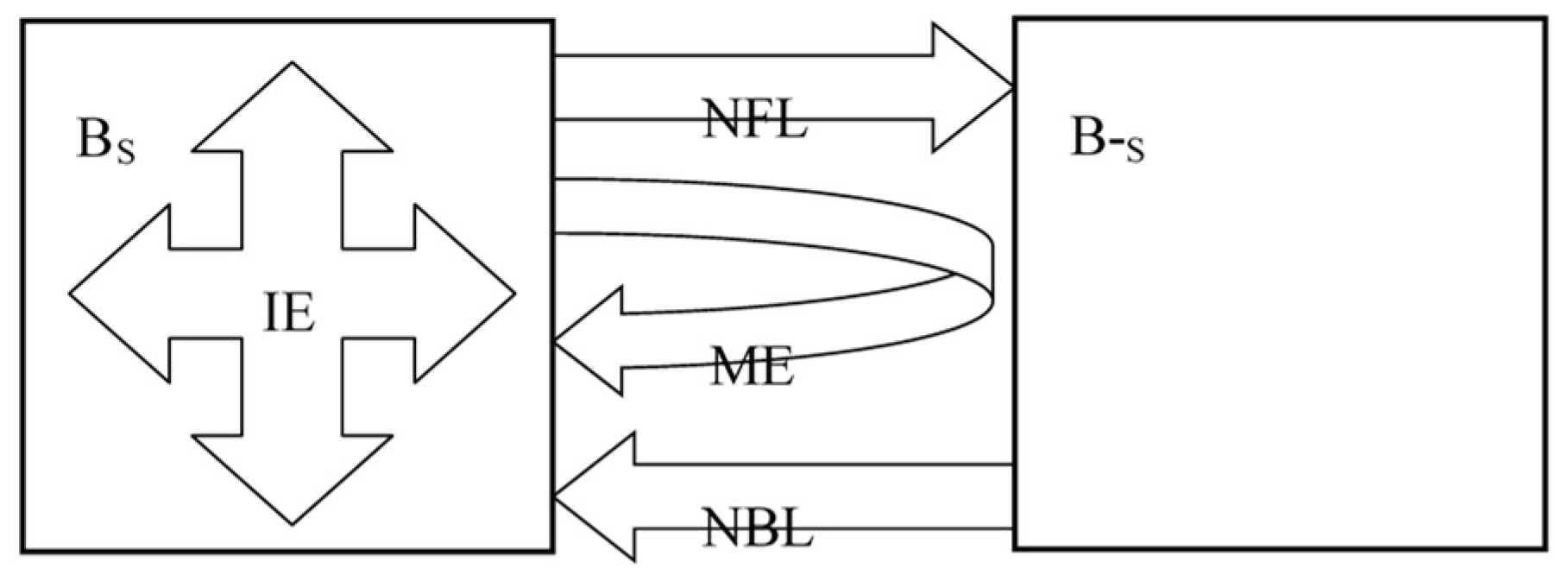
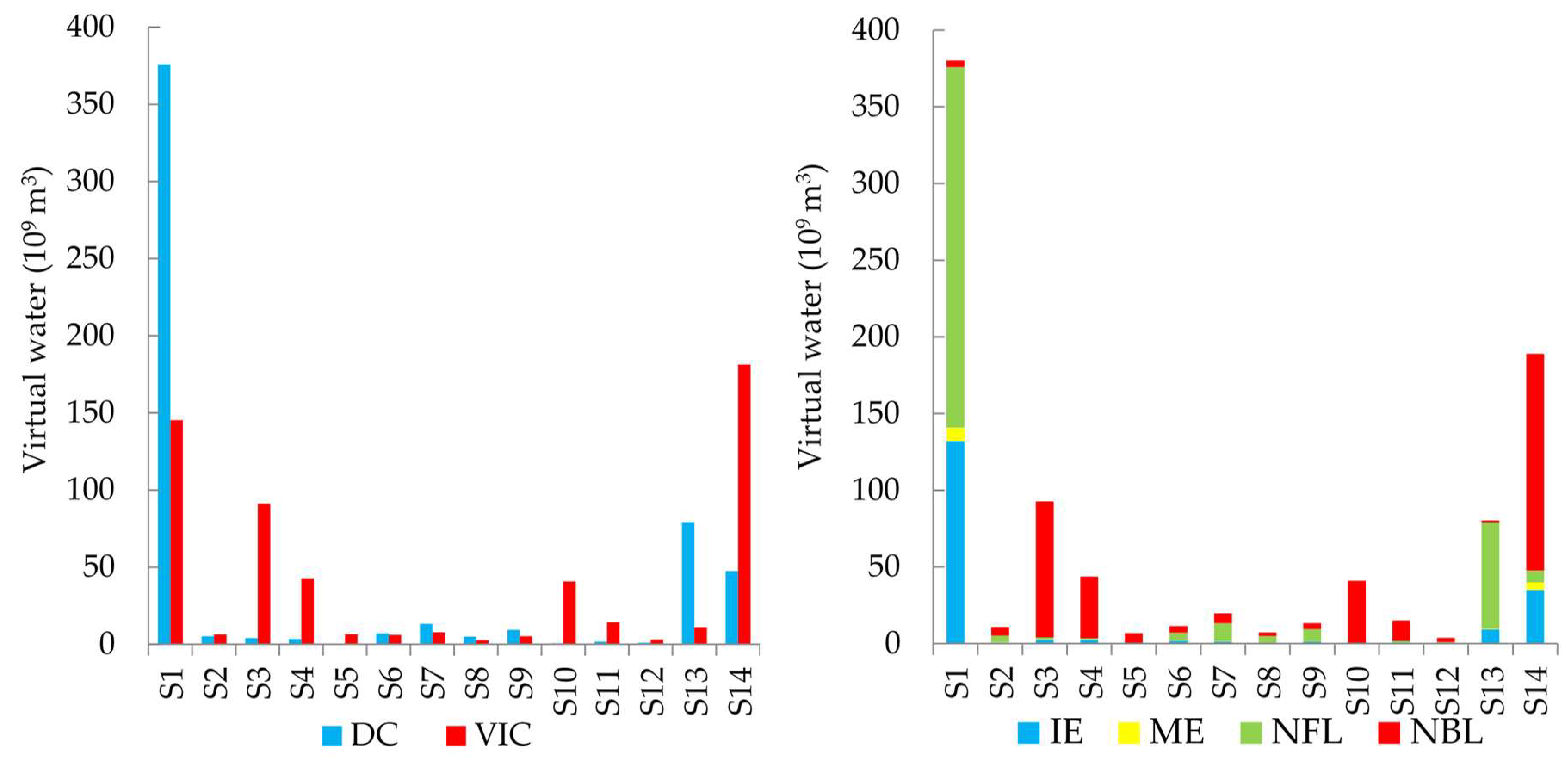

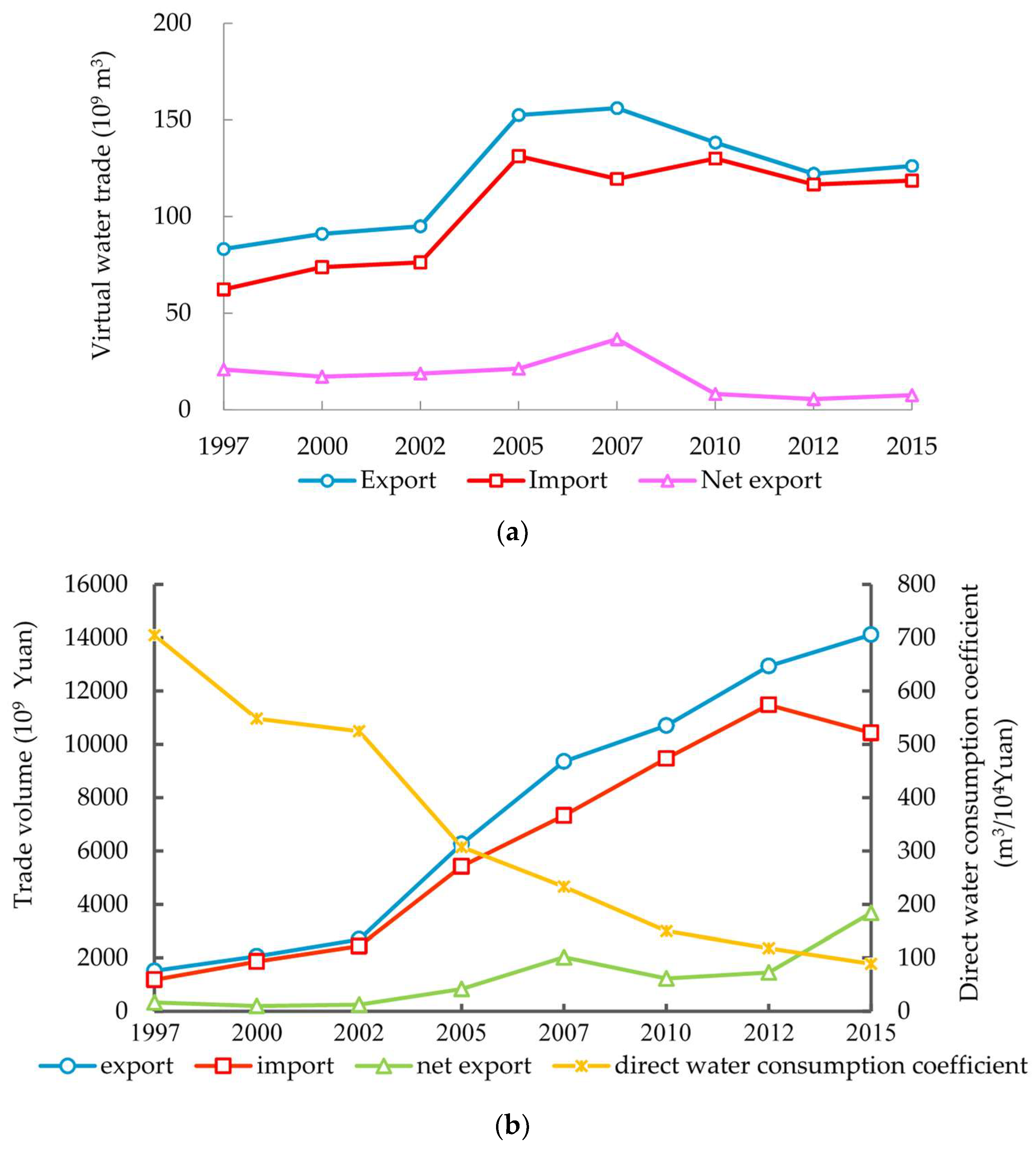




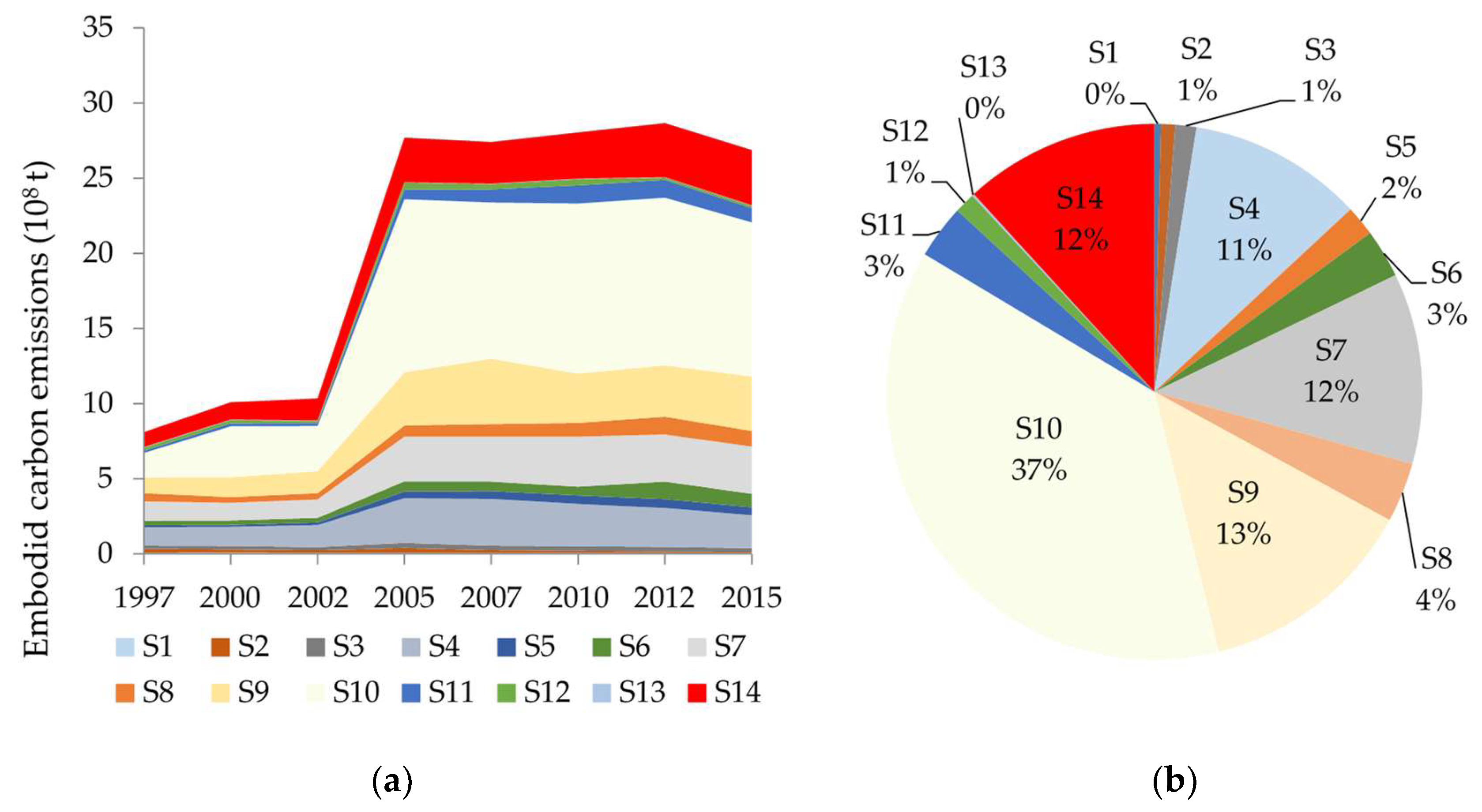

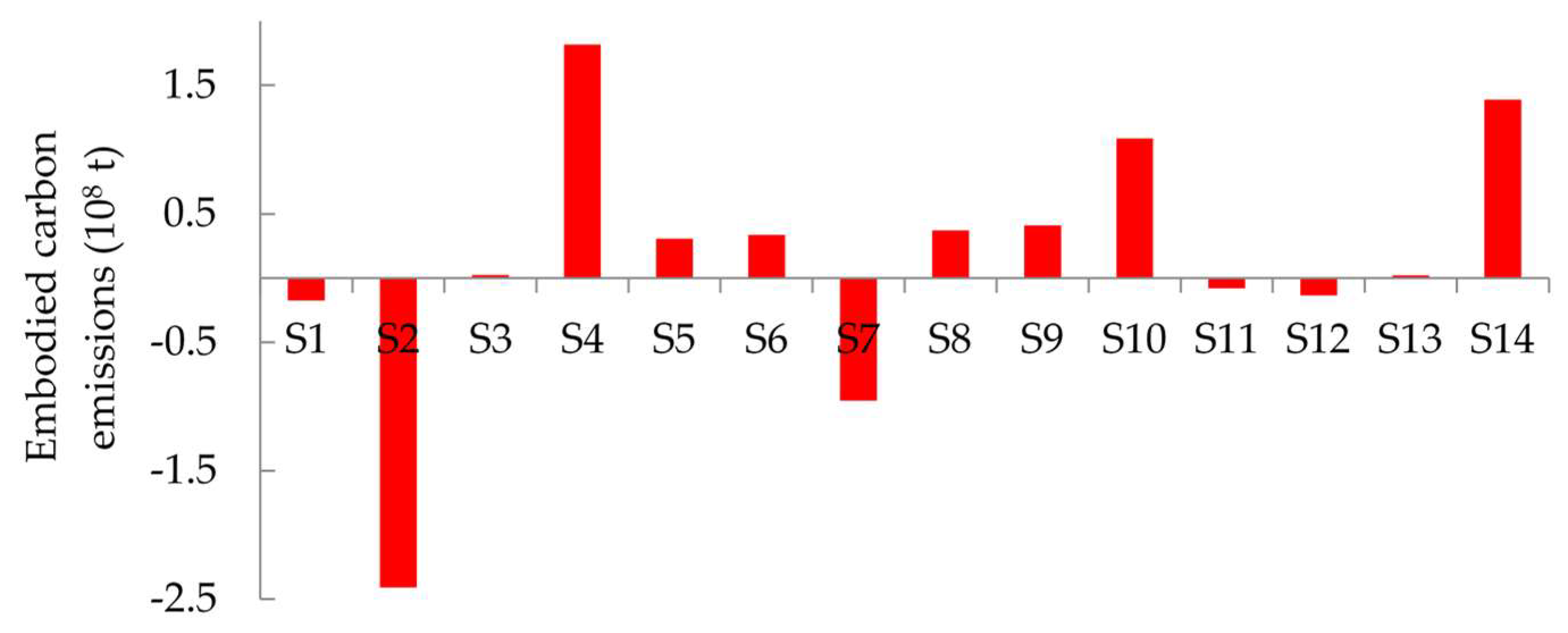

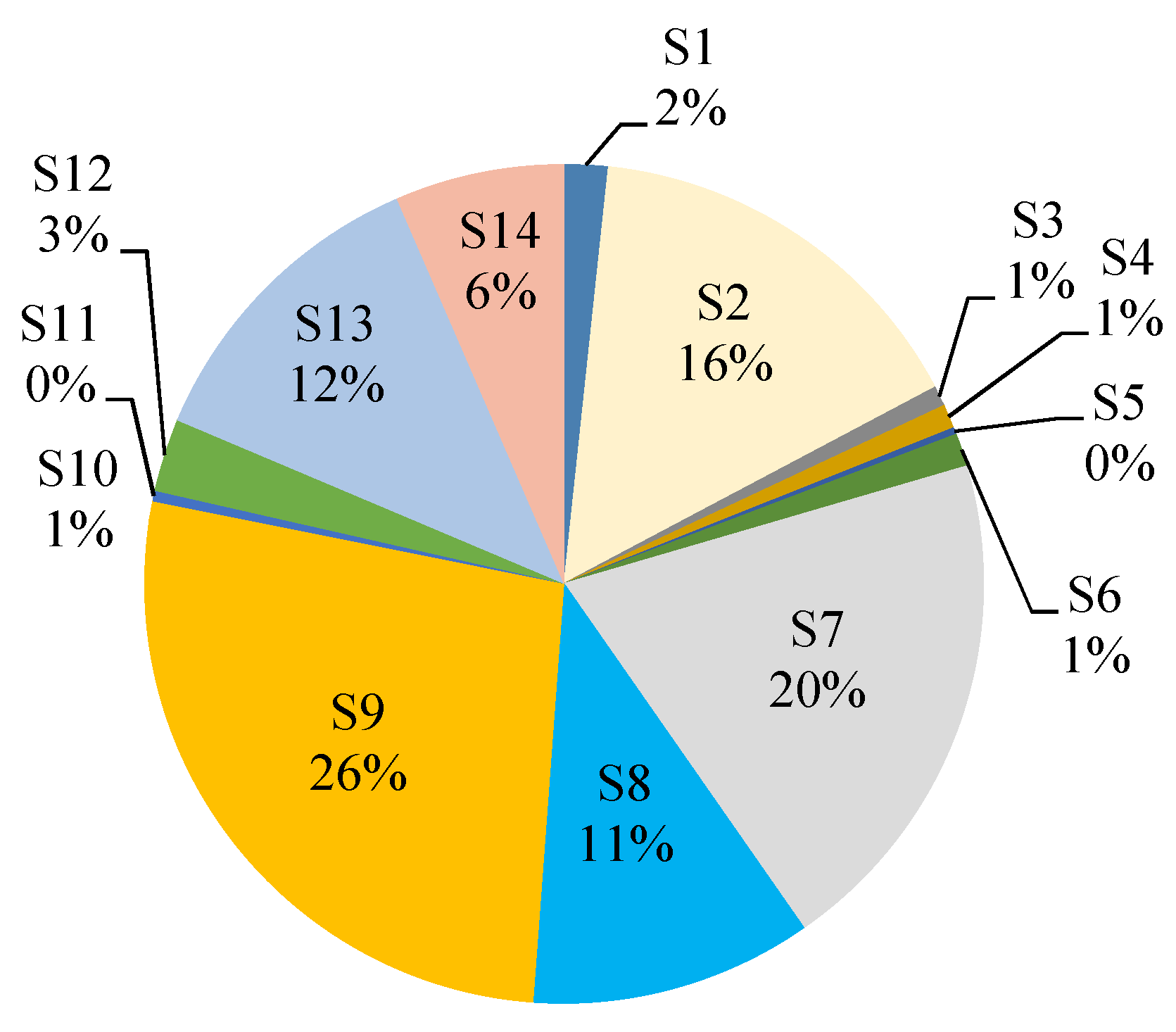
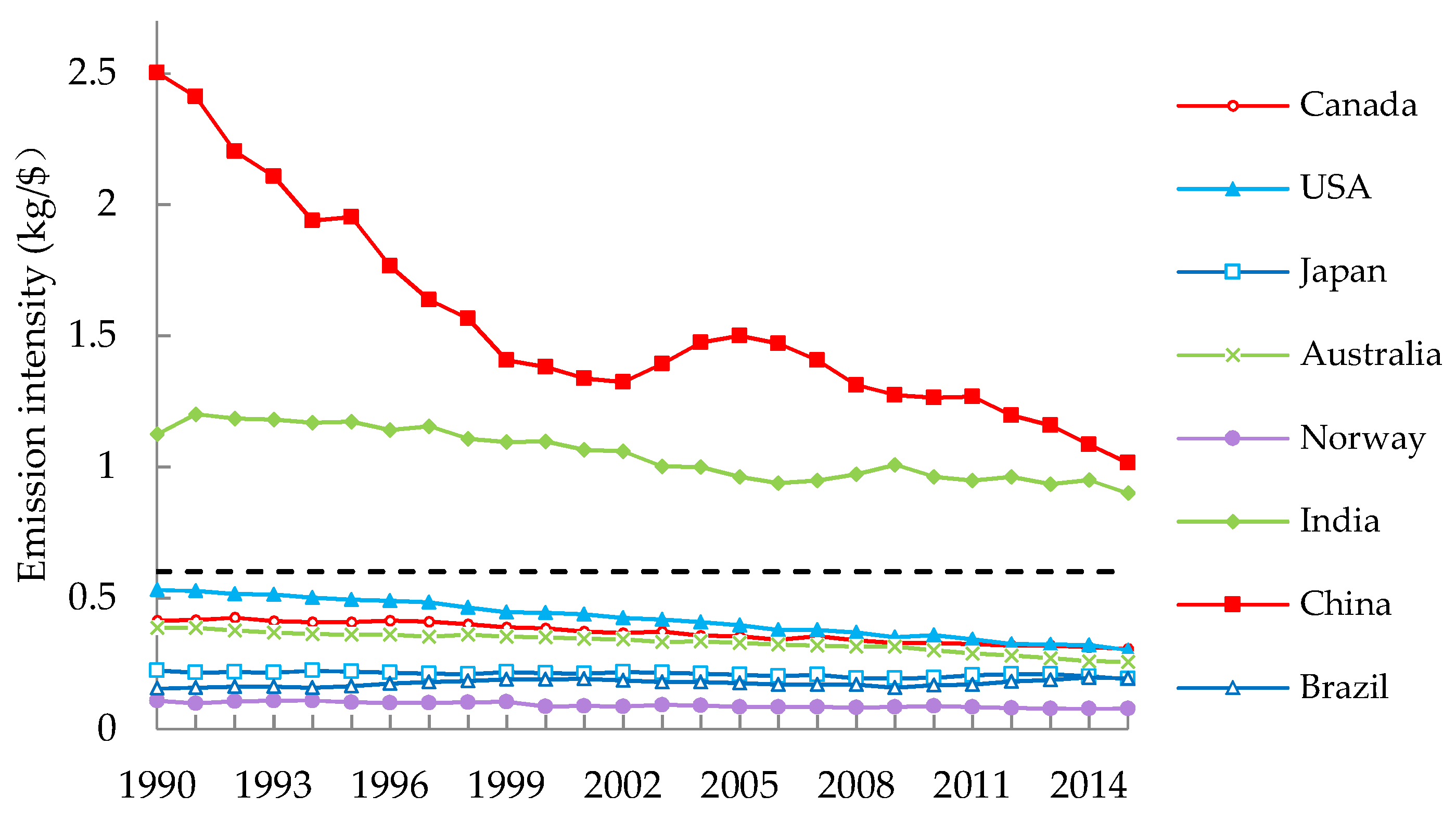
| Code | Merged Sectors | Original Sectors in THE Input–Output Table |
|---|---|---|
| S1 | Agriculture | Agriculture |
| S2 | Mining industry | Coal mining and washing industry; oil and gas mining industry; metal mining industry; non-metallic mineral and other mining industry |
| S3 | Food, beverage and tobacco products | Food, beverage and tobacco products |
| S4 | Textile garment leather products | Textile industry; textile clothing footwear leather down and its products industry |
| S5 | Wood and furniture manufacturing industry | Wood and furniture manufacturing |
| S6 | Paper and printing industry | Paper and printing industry |
| S7 | Petrochemical industry | Oil Processing, coking and nuclear fuel processing industry; chemical industry |
| S8 | Other nonmetallic mineral products industry | Other nonmetallic mineral products industry |
| S9 | Metal products industry | Metal smelting and rolling processing industry; metal products industry |
| S10 | General machinery and equipment manufacturing industry | General equipment manufacturing industry; special equipment manufacturing industry; electrical, mechanical equipment manufacturing; communications, computers and other electronic equipment manufacturing industry; instrumentation and cultural machinery manufacturing industry |
| S11 | Transportation equipment manufacturing industry | Transportation equipment manufacturing industry |
| S12 | Other manufacturing industry | Waste scrap industry; gas production and supply industry; other manufacturing products |
| S13 | Electric and water industry | Electricity, heat production and supply industry; water production and supply industry |
| S14 | Architecture and service industry | construction industry; transportation and warehousing; postal industry; information transmission, computer services and software industry; wholesale and retail trade; accommodation and catering; financial industry; real estate leasing and business services; research and experimental development; integrated technical services; water, environment and public facilities management; resident services and other services; education; health, social security and social welfare; culture, sports and entertainment; public administration and social organization |
| Input/Output | Intermediate Use | Total Use | Import | Gross Output | |||||
|---|---|---|---|---|---|---|---|---|---|
| 1 | 2 | … | n | Expert | Sum | ||||
| Intermediate use | 1 | X11 | X12 | … | X1n | EX1 | Y1 | IM1 | X1 |
| 2 | X21 | X22 | … | X2n | EX2 | Y2 | IM2 | X2 | |
| … | … | … | … | … | … | … | … | … | |
| n | Xn1 | Xn2 | … | Xnn | EXn | Yn | IMn | Xn | |
| Gross input | X1 | X2 | … | Xn | |||||
| Water (energy)consumption | Wd1 | Wd2 | … | Wdn | |||||
| S1 | S2 | S3 | S4 | S5 | S6 | S7 | S8 | S9 | S10 | S11 | S12 | S13 | S14 | Sum | |
|---|---|---|---|---|---|---|---|---|---|---|---|---|---|---|---|
| S1 | 0 | 0.96 | 82.74 | 32.1 | 4.53 | 2.29 | 3.33 | 0.7 | 1.2 | 12.56 | 4.17 | 1.88 | 0.54 | 73.71 | 220.7 |
| S2 | 0.18 | 0 | 0.23 | 0.29 | 0.06 | 0.06 | 0.27 | 0.09 | 0.17 | 1.06 | 0.31 | 0.05 | 0.10 | 2.43 | 5.29 |
| S3 | 0.23 | 0.01 | 0 | 0.14 | 0.01 | 0.01 | 0.02 | 0.01 | 0.01 | 0.11 | 0.04 | 0.01 | 0.01 | 0.75 | 1.34 |
| S4 | 0.03 | 0.01 | 0.04 | 0 | 0.03 | 0.03 | 0.04 | 0.01 | 0.02 | 0.15 | 0.06 | 0.03 | 0.01 | 0.53 | 0.99 |
| S5 | 0 | 0 | 0 | 0 | 0 | 0 | 0 | 0 | 0 | 0.01 | 0.01 | 0 | 0 | 0.06 | 0.1 |
| S6 | 0.14 | 0.04 | 0.48 | 0.34 | 0.06 | 0 | 0.09 | 0.07 | 0.08 | 0.83 | 0.20 | 0.05 | 0.03 | 3.49 | 5.89 |
| S7 | 0.86 | 0.21 | 0.85 | 1.27 | 0.19 | 0.21 | 0 | 0.15 | 0.24 | 2.74 | 0.79 | 0.11 | 0.11 | 7.08 | 14.8 |
| S8 | 0.1 | 0.05 | 0.16 | 0.15 | 0.04 | 0.03 | 0.06 | 0 | 0.11 | 0.86 | 0.23 | 0.03 | 0.02 | 3.3 | 5.14 |
| S9 | 0.19 | 0.13 | 0.29 | 0.3 | 0.1 | 0.09 | 0.13 | 0.09 | 0 | 3.25 | 0.83 | 0.08 | 0.06 | 4.57 | 10.11 |
| S10 | 0.01 | 0.01 | 0.01 | 0.02 | 0 | 0 | 0.01 | 0 | 0.01 | 0 | 0.04 | 0 | 0 | 0.2 | 0.31 |
| S11 | 0.02 | 0.01 | 0.02 | 0.02 | 0.01 | 0.01 | 0.01 | 0.01 | 0.02 | 0.11 | 0 | 0 | 0.01 | 0.42 | 0.66 |
| S12 | 0.02 | 0.01 | 0.04 | 0.05 | 0.01 | 0.06 | 0.02 | 0.02 | 0.04 | 0.25 | 0.06 | 0 | 0.01 | 0.46 | 1.04 |
| S13 | 3.28 | 2.16 | 4.31 | 5.22 | 1.07 | 1.14 | 3.15 | 1.34 | 2.71 | 17.01 | 4.73 | 0.66 | 0 | 40.53 | 87.31 |
| S14 | 0.67 | 0.24 | 1.06 | 1.15 | 0.19 | 0.19 | 0.37 | 0.18 | 0.29 | 2.94 | 0.91 | 0.12 | 0.14 | 0 | 8.44 |
| Sum | 5.73 | 3.84 | 90.23 | 41.05 | 6.3 | 4.12 | 7.5 | 2.67 | 4.9 | 41.88 | 12.38 | 3.02 | 1.04 | 137.53 |
| S1 | S2 | S3 | S4 | S5 | S6 | S7 | S8 | S9 | S10 | S11 | S12 | S13 | S14 | Sum | |
|---|---|---|---|---|---|---|---|---|---|---|---|---|---|---|---|
| S1 | 0 | 0.75 | 34.45 | 13.45 | 2.05 | 1.14 | 1.21 | 0.27 | 0.39 | 5.41 | 2.09 | 0.66 | 0.24 | 33.24 | 95.35 |
| S2 | 15.26 | 0 | 21.6 | 27 | 5.87 | 6.63 | 22.68 | 8.02 | 13.49 | 104.82 | 34.66 | 4.31 | 10.18 | 253.93 | 528.47 |
| S3 | 6.64 | 0.6 | 0 | 4.75 | 0.52 | 0.43 | 0.65 | 0.18 | 0.26 | 4.06 | 1.56 | 0.22 | 0.19 | 27.49 | 47.54 |
| S4 | 0.95 | 0.73 | 1.7 | 0 | 1.24 | 1.48 | 1.18 | 0.37 | 0.49 | 6.18 | 3.30 | 0.97 | 0.24 | 24.98 | 43.81 |
| S5 | 0.26 | 0.38 | 0.46 | 0.49 | 0 | 0.3 | 0.17 | 0.1 | 0.19 | 1.9 | 1.06 | 0.11 | 0.07 | 9.37 | 14.86 |
| S6 | 1.42 | 0.82 | 5.46 | 3.94 | 0.77 | 0 | 0.84 | 0.72 | 0.74 | 9.81 | 2.7 | 0.47 | 0.32 | 44.93 | 72.94 |
| S7 | 47.4 | 22.84 | 58.14 | 82.46 | 14.41 | 17 | 0 | 9.08 | 12.29 | 184.18 | 64.57 | 6.44 | 7.65 | 540.64 | 1067.11 |
| S8 | 9.49 | 9.06 | 19.74 | 17.49 | 4.42 | 3.9 | 5.64 | 0 | 9.52 | 98.02 | 30.44 | 2.70 | 2.85 | 448.23 | 661.5 |
| S9 | 17.29 | 30.07 | 33.42 | 34.1 | 12.86 | 13.28 | 11.08 | 8.86 | 0 | 418.52 | 132.72 | 8.00 | 7.74 | 638.7 | 1366.65 |
| S10 | 1.08 | 1.5 | 1.66 | 2.05 | 0.43 | 0.51 | 0.77 | 0.44 | 0.66 | 0 | 6.15 | 0.25 | 0.67 | 29.75 | 45.9 |
| S11 | 0.53 | 0.26 | 0.69 | 0.68 | 0.14 | 0.17 | 0.29 | 0.13 | 0.36 | 3.25 | 0 | 0.11 | 0.15 | 13.77 | 20.52 |
| S12 | 1.86 | 1.98 | 4 | 4.61 | 1.24 | 4.87 | 1.39 | 1.27 | 2.92 | 24.47 | 6.87 | 0 | 0.63 | 50.48 | 106.59 |
| S13 | 13.9 | 17.75 | 21.45 | 25.7 | 5.83 | 6.31 | 12.91 | 6.03 | 10.91 | 86.95 | 28.05 | 3.00 | 0 | 222.89 | 461.7 |
| S14 | 10.47 | 8.76 | 21.79 | 22.03 | 4.25 | 4.47 | 5.26 | 2.77 | 4.48 | 63.71 | 24.09 | 1.96 | 3.15 | 0 | 177.19 |
| Sum | 126.55 | 95.5 | 224.56 | 238.75 | 54.03 | 60.49 | 64.07 | 38.24 | 56.7 | 1011.28 | 338.26 | 29.2 | 34.08 | 2338.4 |
© 2018 by the authors. Licensee MDPI, Basel, Switzerland. This article is an open access article distributed under the terms and conditions of the Creative Commons Attribution (CC BY) license (http://creativecommons.org/licenses/by/4.0/).
Share and Cite
Huang, H.; Li, X.; Cao, L.; Jia, D.; Zhang, J.; Wang, C.; Han, Y. Inter-Sectoral Linkage and External Trade Analysis for Virtual Water and Embodied Carbon Emissions in China. Water 2018, 10, 1664. https://doi.org/10.3390/w10111664
Huang H, Li X, Cao L, Jia D, Zhang J, Wang C, Han Y. Inter-Sectoral Linkage and External Trade Analysis for Virtual Water and Embodied Carbon Emissions in China. Water. 2018; 10(11):1664. https://doi.org/10.3390/w10111664
Chicago/Turabian StyleHuang, Huiping, Xinsheng Li, Lianhai Cao, Dongdong Jia, Junlong Zhang, Chunying Wang, and Yuping Han. 2018. "Inter-Sectoral Linkage and External Trade Analysis for Virtual Water and Embodied Carbon Emissions in China" Water 10, no. 11: 1664. https://doi.org/10.3390/w10111664
APA StyleHuang, H., Li, X., Cao, L., Jia, D., Zhang, J., Wang, C., & Han, Y. (2018). Inter-Sectoral Linkage and External Trade Analysis for Virtual Water and Embodied Carbon Emissions in China. Water, 10(11), 1664. https://doi.org/10.3390/w10111664






